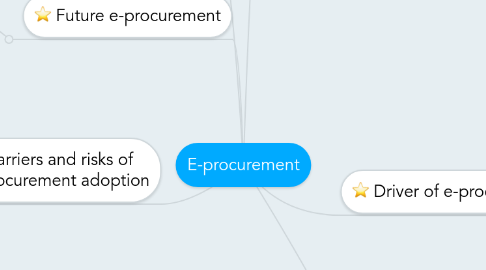
1. Benefits of e-procurement
1.1. Planning
1.1.1. increase the quality and dissemination of management information
1.2. Development
1.2.1. help accelerate development
1.3. Inbound
1.3.1. vendor-managed inventory(VMI)
1.3.1.1. supply chain partners will manage the replenishment of part
1.4. Production
1.4.1. ensure that manufacturing is not limited by poor availability of parts
1.5. Outbound
1.5.1. to achieve efficient consumer response(ECR)
1.6. Cost reduction
2. Barriers and risks of e-procurement adoption
2.1. Issues
2.1.1. Competition issue
2.1.2. Possible negative perception from suppliers
2.1.3. Negotiated procurement benefits
2.1.4. Creation of catalogues
2.1.5. Culture profile within organization
2.2. Risks
2.2.1. Technology risks
2.2.2. redeploy staff
2.2.3. resistance to the introduction of the system
3. Future e-procurement
3.1. software agents
3.1.1. software program that assist humans by automatically gathering information from the internet
4. Implementing e-procurement
4.1. Types of system
4.1.1. stock control system
4.1.1.1. mainly to production-related procurement
4.1.2. web-based catalog
4.1.2.1. paper catalog have been replaced by electronic form
4.1.3. e-mail
4.1.3.1. integrate the entry of the order by the original nator
4.1.4. Order-entry on website
4.1.4.1. buyer has opportunity to order directly on the suppliers'website
4.1.5. Accounting system
4.1.5.1. enable staff in the buying department to enter an order
4.1.6. ERP system
4.1.6.1. integrate all the facility above
5. What is e-procurement?
5.1. Procurement
5.1.1. All activities involved with obtaining items from a suppliers
5.2. E-procurement
5.2.1. Electronic integration of all procurement activities including purchase request, ordering, delivery and payment between suppliers and purchaser
5.3. Five right of purchasing
5.3.1. at the right price
5.3.2. delivered at the right time
5.3.3. of the right quality
5.3.4. of the right quantity
5.3.5. from the right sourc
5.4. Types of procurement
5.4.1. E-sourcing
5.4.1.1. finding potential new suppliers
5.4.2. E-tendering
5.4.2.1. process of screening suppliers and request for price(RFP)
5.4.3. E-informing
5.4.3.1. qualification of suppliers for suitability
5.4.4. E-reverse auctions
5.4.4.1. enable purchasing company to buy goods and services
5.4.5. E-MRO
5.4.5.1. purchase and supply of product
6. Driver of e-procurement
6.1. Control
6.1.1. improving compliances, achieving centralization and improved auditing data
6.2. Cost
6.2.1. improved buying leverage through increasing supplier competition, monitoring saving target and transactional cost reduction
6.3. Process
6.3.1. reduced cycle time, improved visibility of process and efficient invoice settlement
6.4. Process
6.4.1. reduced cycle time, improve visibility of process and efficient invoice settlement
6.5. Individual performance
6.5.1. knowledge sharing, value-add productivity and productivity improvement
6.6. Supplier management
6.6.1. reduced supplier numbers, supplier management and selection and integration
